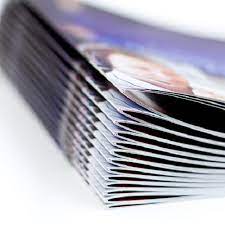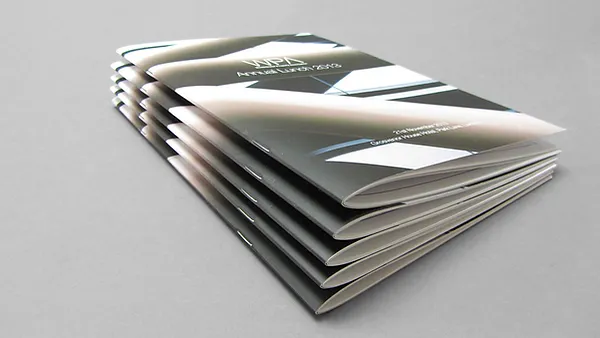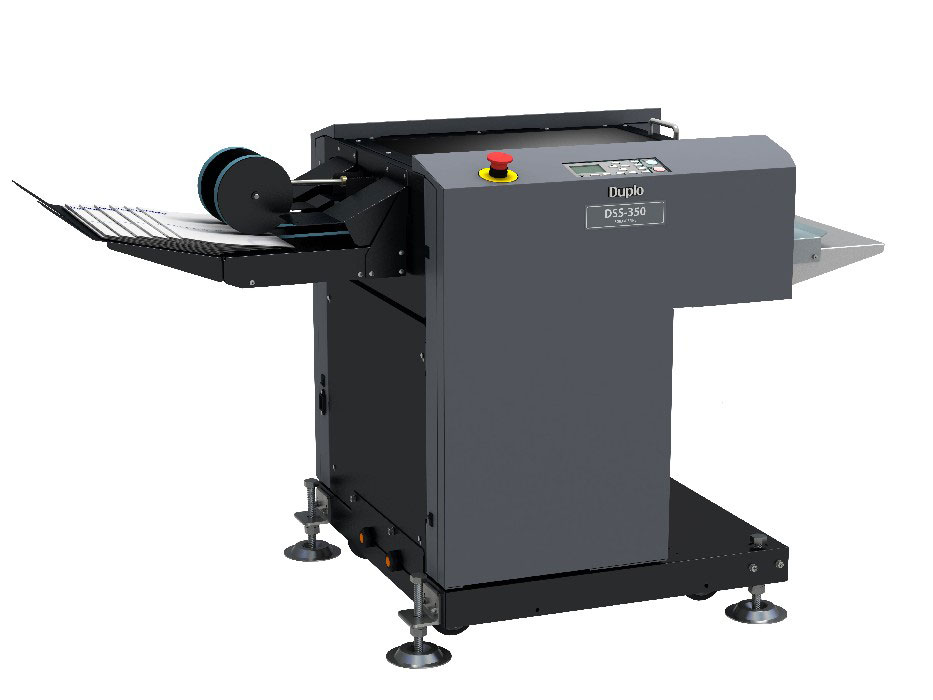
When it comes to producing booklets, brochures, catalogues magazines, or any other bound printed materials, selecting the binding technique is extremely important. One of the most popular and cost-efficient option is Stapled Book printing (otherwise known as Saddle Stitch Book Printing), which happens to be an MVP Print speciality. Saddle stitch binding is generally more cost-effective for short print runs compared to methods involving more complex setups, such as perfect bound booklets. Saddle stitch booklets typically range from 8 to 76 pages, making them suitable for low to medium page count projects.
What is Stapled Book Printing?
Stapled book printing, also known as saddle stitching, is a popular and cost-effective binding technique for producing a variety of printed materials such as booklets, brochures, catalogues, and marketing collateral. This straightforward printing process involves folding sheets of paper in half and stapling them together along the folded crease or “saddle” of the pages, resulting in a professional-looking booklet that opens flat.
Saddle Stitching Process
To create a stapled booklet, multiple sheets of paper are folded in half, laid across a “saddle,” then stapled together along the spine with two wire staples to form the “stitches.” This method ensures that the booklet opens flat, making it a suitable solution for documents with a moderate number of pages, typically between 8 and 76 pages.
Stapled Book Applications
Stapled books or saddle-stitched booklets are versatile and can be used for a wide range of applications, including marketing collateral, event programs, product catalogues, magazines, presentations, and more. The compact and cost-effective nature of stapled books makes them an ideal choice for businesses, event organizers, and marketing teams looking to create high-quality printed materials on a budget.
Stapled Book – A Cost-Effective Binding Solution

Saddle stitching offers a significant economical advantages over alternative bookbinding techniques, particularly for stapled books, brochures, and similar printed materials. Some of the key reasons why it is a cost-effective binding solution include:
Utilises Minimal Binding Materials
Saddle stitch binding requires only the essential materials – paper and staples – making it a budget-friendly option for businesses and organizations seeking to produce small to medium-sized booklets, catalogues, and other marketing collateral.
Straightforward Setup Process
The setup process for saddle-stitched booklets is relatively simple, often involving just folding the sheets in half and stapling them along the crease. This streamlined approach helps to reduce production costs and setup time, making it an efficient solution for short-run print jobs.
The Stapled Book is Scalable for Short and Long Print Runs
Saddle stitch binding is versatile, suitable for both small and large print runs. Whether a business requires a few dozen booklets or several thousand, the cost-effectiveness of this binding method remains consistent, making it a practical choice for a wide range of printing needs.
Quick Turnaround Times
One of the key benefits of opting for saddle-stitched booklets from MVP Print is the ultra-fast turnaround time. Whether businesses need books or booklets for a last-minute trade show, an event, or a promotional campaign, saddle stitch is the quickest binding option, particularly for booklets that have a self-cover. Artwork must be supplied print ready or approved by 10 am to be printed same/next day, and 99% of the time, printing within the required timeframe should be possible.
However, quick turnaround product times are subject to change depending on factors like staff availability or machine breakdowns. Factors beyond the printing service’s control may also affect meeting tight fixed deadlines. It’s recommended to contact MVP Print before placing an order for a tight fixed deadline to ensure the order can be fulfilled within the desired timeframe.
Limitations on Page Count
While saddle stitching is a versatile binding option, it does have limitations when it comes to the number of pages each book or booklet can hold. Typically, saddle-stitched booklets work best for projects that have a page count (or booklet size) between 8 and 72 pages. This range ensures the booklet maintains its structural integrity and readability, without compromising the quality of the final product.
Ideal Page Range
The recommended maximum page count for a saddle-stitched booklet is typically around 60 to 70 pages. This page range ensures the booklet retains its shape and the pages remain securely bound, without the need for additional binding materials or techniques. Booklets with fewer than 8 pages may not provide enough content, while those exceeding 76 pages can become unwieldy and challenging to handle.
Thickness and Readability Challenges
As the page count for a saddle-stitched booklet increases, the overall thickness of the publication can become a limiting factor. Exceeding 60 to 70 pages may result in the booklet feeling too bulky or cumbersome, which can detract from the reading experience. Additionally, the binding process may become more challenging, potentially leading to uneven pages or difficulty in opening the booklet flat. For projects with a higher page count, alternative binding methods, such as perfect binding, may be more suitable to maintain a professional and cohesive appearance.
Stapled Book for Short Print Runs

For print runs under 500 booklets, a standard saddle-stitching approach works well. This hand-fed stitching method is cost-effective and efficient, making it ideal for businesses, event promotions, and marketing campaigns. Saddle stitched booklets are a popular choice for a variety of printed materials, including stapled book, stapled booklets, stapled booklet, marketing collateral, single pages, full colour, cover design, booklet, page, paper, printed, cover, booklets, print, staple, blank, colour, stapled, customers, sheets, spine, enhance, covers, contact, staples, catalogues, images, folded, photos, binding, create, half, magazines, presentation, fill, bound, ideas, uncoated, life, fold, scan, edges, write, and download.
Hand-Fed Stitching for Stapled Book Printing

The hand-fed stitching process involves manually feeding each individual sheet of paper into the saddle stitching machine, which then folds and staples the pages together along the spine. This method is well-suited for smaller print runs, as it is a cost-effective and efficient way to produce high-quality stapled books with blank pages, inner pages, uncoated paper, and self-cover finishes.
Ideal for Marketing and Promotional Materials
Stapled book printing using the hand-fed saddle stitching technique is particularly well-suited for marketing and promotional materials. Businesses can create engaging booklets, catalogues, and other printed collateral to showcase their products, services, and brand. The quick turnaround time and cost-effectiveness of this binding method make it an attractive option for a wide range of industries, including retail, professional services, and more.
Stapled Book for Longer Print Runs

For print runs in the thousands or more, businesses might consider high-speed saddle stitching. This automated process uses wire staples (spooled) machinery to bind booklets, making it a practical choice for materials, product catalogues, and extensive publications.
High-Speed Saddle Stitching
The high-speed saddle stitching process allows for efficient and cost-effective booklet production, even at larger scales. This automated approach utilises specialised machinery that can quickly bind multiple pages together using wire staples, ensuring a professional and consistent finish for your stapled books, catalogues, or marketing collateral.
Automated Process with Wire Staples
The automated wire stapling process is well-suited for longer print runs, as it can handle high volumes with minimal manual intervention. This streamlined method employs spooled wire staples, which are fed directly into the binding equipment, resulting in a seamless and efficient booklet production workflow. The wire staples provide a durable and secure binding, making them ideal for items that require frequent handling or distribution, such as product catalogues, magazines, and presentation materials.
Alternative Binding Methods
While saddle stitching is a popular and cost-effective binding method, there are alternative binding options available for certain printing projects. Two of the most common alternatives are perfect binding and coil or wire-o binding.
Perfect Binding
Perfect binding, also known as adhesive binding, is a popular choice for producing softcover books, catalogues, magazines, and other publications. This method uses a strong adhesive to bind the pages together along the spine, resulting in a clean, professional look. Perfect binding is suitable for print runs of all sizes, from short runs to longer production volumes. It’s commonly used for materials such as product brochures, company reports, and high-quality marketing collateral.
Coil or Wire-O Binding
Coil or wire-o binding is a versatile option that allows books and booklets to open completely flat and rotate a full 360 degrees. This binding method uses a looped wire or plastic coil that is inserted through pre-punched holes along the spine. Coil and wire-o binding work well for manuals, workbooks, presentations, and any other materials that require a durable yet flexible binding solution. They can accommodate a wide range of page counts, from small pocket-sized booklets to larger publications.
Stapled Book from MVP Print
When it comes to producing high-quality stapled books, MVP Print offers a range of options to cater to the diverse needs of their customers. One of the key advantages of choosing MVP Print for your stapled book printing is the wide selection of paper stocks available.
Wide Range of Paper Stocks
MVP Print understands that the choice of paper can significantly impact the overall look and feel of a stapled book. That’s why they offer a comprehensive range of paper options, including uncoated paper, self-cover, and a variety of weights and finishes. Customers can choose from high-quality uncoated paper, blank pages, and inner pages to create the perfect booklet, brochure, or catalogue that aligns with their brand and design preferences.
Customisation Options
In addition to the diverse paper selection, MVP Print also provides ample opportunities for customisation. Clients can opt for full colour printing to showcase their cover design, pages, and booklet content, or choose a more cost-effective single page or self cover option. This flexibility allows businesses and organisations to create marketing collateral that is tailored to their specific needs and budget.
Whether you’re looking to produce stapled booklets, stapled books, or any other type of printed booklets, MVP Print’s expertise in staple, blank, colour, and stapled binding solutions ensures that your project will be executed to the highest standards. With their commitment to customer satisfaction and attention to detail, MVP Print is the ideal partner for all your stapled book printing requirements.
Choosing the Right Binding Method

When it comes to printing booklets, brochures, or other multi-page materials, the choice of binding method can significantly impact the final product’s appearance, functionality, and cost-effectiveness. Businesses should carefully consider their specific needs and project requirements when selecting the appropriate binding solution.
For documents with a limited page count, such as marketing collateral or single-page handouts, a simple stapled binding can provide a clean and professional look without breaking the bank. Stapled booklets are a cost-effective option for small to medium-sized publications, offering a straightforward binding process that works well for up to 64 pages.
On the other hand, for softcover books, magazines, and brochures with a wider range of page counts, perfect binding may be the more suitable choice. This method creates a polished, square-spine finish that is durable and ideal for products you want to showcase, such as catalogues or paperback books.
Ultimately, the decision between stapled, perfect, or alternative binding methods like wire-o or case binding should be based on factors such as document type, page count, budget, and the desired appearance. By carefully evaluating these considerations, businesses can ensure they select the binding solution that best meets their printing and publishing needs.
FAQ
What is Stapled Book Printing ?
Stapled Book Printing, or Saddle stitching, is a common bookbinding method that involves folding sheets of paper in half and stapling them together along the folded crease or “saddle” of the pages. This results in a professional-looking booklet that opens flat.
What are the benefits of Saddle Stitched Booklets?
Saddle stitched booklets offer several advantages, including being a cost-effective binding solution, having a quick turnaround time, and being suitable for projects with a moderate number of pages (typically between 8 and 76 pages).
What page count works best for Stapled Book Printing ?
Saddle stitched booklets work best for projects with a page count between 8 and 76 pages. Beyond this range, the booklet may become too thick or compromise readability.
How do I choose between different binding methods for my printing project?
When selecting a binding method, businesses should carefully consider their specific needs and project requirements, such as the number of pages, print run size, and desired appearance. Saddle stitching may be a cost-effective option for some projects, while alternative binding methods like perfect binding or coil/wire-o binding may be more suitable for others.
What paper stocks are available for Stapled Book Printing at MVP Print?
MVP Print offers a wide range of paper stocks for stapled book printing, allowing customers to choose the best option for their project’s needs and preferences.
Can I customise my Stapled Book from MVP Print?
Yes, MVP Print provides various customisation options for stapled books, allowing businesses to tailor the final product to their specific requirements, including cover design, paper stocks, and more.







